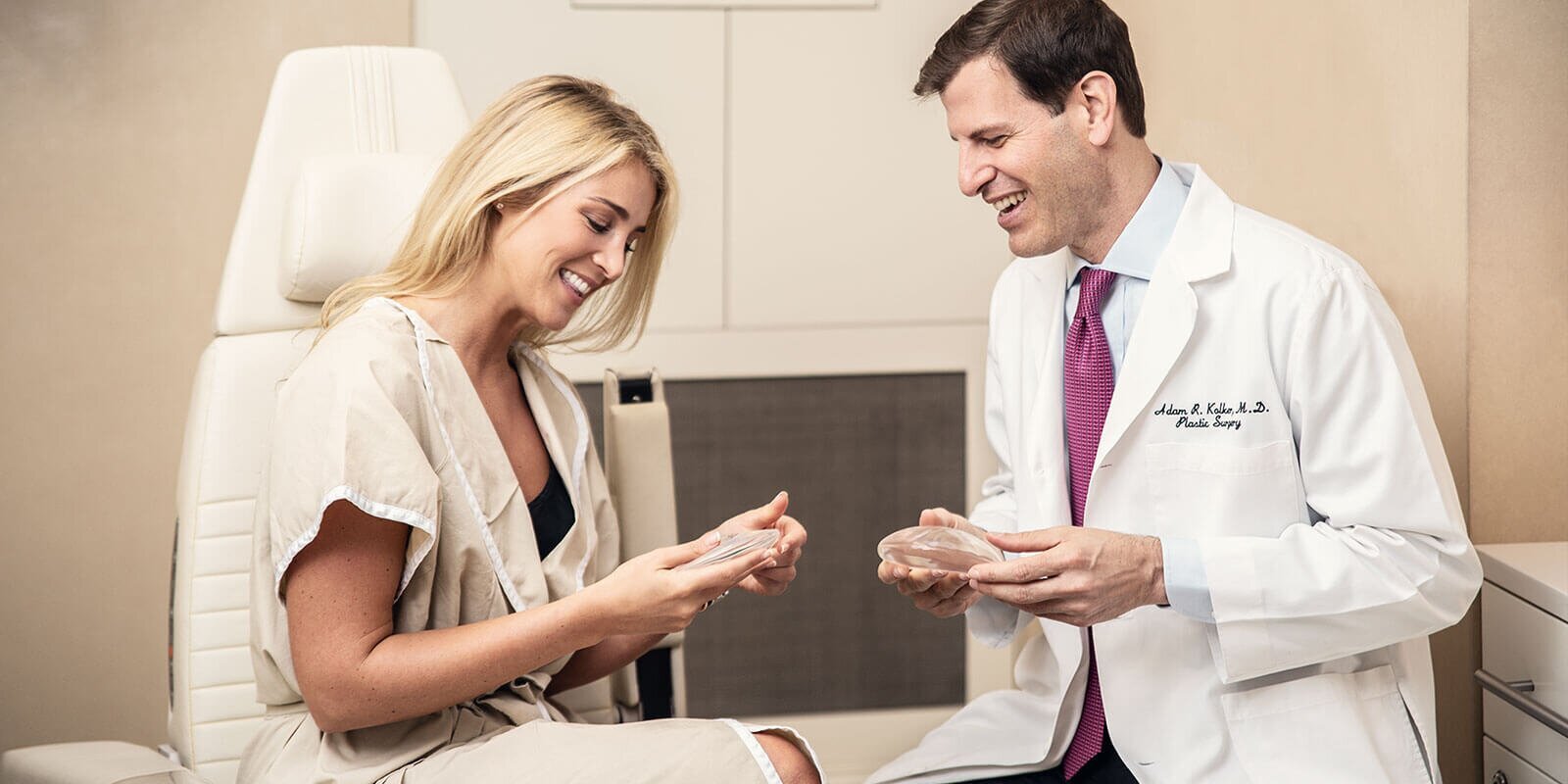





When considering breast augmentation, the most frequently asked questions relate to the breast implants themselves. What are the types of breast implants? Should I choose silicone or saline? Are breast implants safe? What are the differences in breast implant shape and style? How do I choose the best breast implant size?
There are now a variety of choices available to women contemplating breast augmentation, and the selection of the best breast augmentation surgery techniques and the best breast implants can be mystifying. An overview of breast enlargement surgery is presented at our Breast Augmentation page, and more specific information regarding breast implants can be found below.
While this website can be helpful in providing basic information about breast implants, there is no substitute for a personal consultation with a board-certified plastic surgeon with expertise and experience in all facets of breast augmentation surgery and the most up-to-date knowledge of breast implant types, and the best breast implant choices to suit your unique desires.
These Breast Augmentation before and after pictures represent actual patients from Dr. Kolker. They will help to assist you in understanding your various options and enable you to set realistic goals for your own surgical outcome. Click on a patient for their specific case details.
Breast enlargement with breast implants has ranked consistently among the most common elective plastic surgery procedures in the USA.
According to 2013 data collected by the American Society of Plastic Surgeons and the American Society for Aesthetic Plastic Surgery, breast augmentation procedures have experienced a 371 percent increase since 1997. There are a number of factors that are responsible for this surge in breast augmentation popularity, primary among which are the evolution of breast implants in design and breast implant fill, and the increasing safety of breast implants and breast augmentation surgery.
There are two main choices of breast implants available today: silicone breast implants and saline breast implants. These implants have a number of similarities, primary among which is that they are both FDA-approved and have a very high safety profile.
Both have similar coverings or outer shells, made of a silicone elastomer. Silicone implants are pre-filled with a cohesive silicone gel, and saline implants are filled with saline solution (identical to IV fluid) during surgery. At similar fill volumes in most women, the difference in the appearance of breasts with silicone or saline implants is imperceptible. The feel of these implants differs slightly, in that silicone implants may be perceived as more natural to the touch. In extremely slim women with minimal native breast and soft tissue cover, both implants can be perceptible; saline implants may be more likely to be associated with some rippling along the edges of the implants. As saline implants are inserted devoid of volume, and are then filled within the breast pocket, a slightly smaller incision may be required for insertion compared with a pre-filled silicone gel implant. For implant volumes below 300 cc, there is little difference in incision length.
Silicone Implants
Saline Implants
Breast implants are available in a wide variety of shapes, profiles, and sizes. Breast implants may have combinations of the following characteristics.
Implant profile refers to the projection of an implant for a given base dimension. Choices are made from among three profiles, corresponding to low or moderate projection (less volume and anterior convexity), midrange or moderate plus projection (intermediate volume and convexity), and high profile (maximum volume and dome-like convexity). When striving for the most aesthetic, attractive, natural shape, the moderate (low) and moderate plus (midrange) profiles are most often selected.
The style of breast implants used for breast augmentation is most commonly round. A round implant will naturally assume a tear-drop shape when upright, will softly “round” when lying down. Anatomically shaped silicone-filled breast implants are an option for select individuals that may be less prone to upper pole fullness.
The size of breast implants is generally quantified as volume in cubic centimeters, or cc. While the volume is indeed important, the most important factors in choosing the final implant size are predicated on your measured breast base dimensions, your skin and soft tissue elasticity, your body shape and proportion, and your desires. Choosing the size of breast implants begins during your initial consultation with Dr. Kolker, where he will unite your physical attributes and needs with your desires in the first phase of the breast augmentation planning process. This will be further confirmed after a preoperative visit to the office where “sizing exercises” are done, during which volume sizers are tried in a specialized brassiere. The final selection will be made based on the breast implant size and profile that create the most beautiful overall breast aesthetics, natural proportion, and balance.
A Keller Funnel is a device used for introducing silicone implants through any breast augmentation incision. Whether through an incision in the lower breast crease (inframammary fold), on the lower margin of the areola, or within the underarm, The Keller Funnel enables the insertion of silicone breast implants through smaller incisions and with minimal or no skin contact. Dr. Kolker uses a Keller Funnel for all primary breast augmentation procedures during which silicone breast implants are used.
The fees associated with breast augmentation surgery incorporate the anesthesia fee, facility fee, surgeon fee, and the cost of breast implants. Cohesive gel silicone breast implants cost slightly more than saline breast implants. The choice of access incision for breast augmentation as it relates to the total surgical time will also have an impact on the cost of breast augmentation. After a careful examination, and discussion of your unique goals, a breast augmentation treatment plan will be outlined with a comprehensive price of breast implants tailored specifically to your needs.
Leak, deflation, or rupture of a breast implant is an extremely rare occurrence within the first ten years following breast augmentation. Breast implants are, however, medical devices that are not expected to last forever. In general, one can anticipate the possibility of exchanging breast implants 10 to 15 years after the initial breast augmentation procedure. As time progresses thereafter, the possibility becomes a probability. A saline implant has an estimated leak or deflation rate that may be approximately 0.5 to 1% per year.
Cohesive silicone gel implants are even less likely to leak, and may experience a rupture rate of below 0.5 % per year; silicone implant rupture rates may even be as low as ¼% to 1/8% (in one study a 1% rupture rate was shown at 6 years). Albeit rare, a saline implant leak will be clinically obvious, with a slow deflation of breast size as the saline water is uneventfully absorbed and the breast becomes visibly and palpably smaller. On the other hand, a silicone implant rupture is silent, as the firmer, cohesive gel will not migrate or be absorbed. Hence, it is recommended that MRI scans are obtained periodically to most reliably assess the silicone implant shell. Consequently, silicone implants do require heightened long-term surveillance. For all breast implants, it is therefore expected that implant exchange should be considered after approximately 10 years.

Breast implants are appropriate for the treatment of a wide array of breast size and shape concerns. Underdevelopment of the breasts, known as developmental breast hypoplasia, is a common indication for breast augmentation. Breast deflation following pregnancy (postpartum glandular hypomastia), after significant weight loss, or simply due to gradual involution can be improved significantly with breast augmentation. Certain breast asymmetries and congenital breast shape deformities can also be corrected through breast augmentation techniques. The technical approach must be meticulously tailored and personalized for every nuance of intrinsic shape and size and for every facet of individual desire.
Regarding the safety of the current generation of breast implants, both saline and silicone implants are FDA approved and are an outstanding choice for breast enlargement with a substantial safety profile that is supported by considerable data.
There is, however, a degree of “urban mythology” associated with breast implants, particularly as a carry-over from tales of generations past. Breast implants were first used in 1962, and have undergone evolutionary changes over the past half-century. Saline breast implants were the first to be used for breast augmentation, and were joined by silicone implants in 1968. By the 1980s, silicone breast implants became the most commonly used breast implants. Despite silicone implant effectiveness and popularity, the FDA felt the existing early generation silicone implant data provided by the manufacturers was insufficient, and a moratorium on silicone implants was issued in 1992. From 1992 through 2006 only saline implants were available for use in the United States.
Meanwhile, elsewhere around the world, silicone implants endured as the most popular breast implants for breast enlargement. After two major adjunct studies in which Dr. Kolker participated, and following an exhaustive review of the data provided by Allergan and Mentor, the two primary manufacturers of breast implants, the FDA approved silicone implants. Since FDA approval of silicone implants in November 2006, these next-generation cohesive gel silicone implants have enjoyed a renaissance, and are once again the predominant breast implants in the USA. Sientra’s silicone gel implants (a third manufacturer) received FDA approval for its Silimed silicone breast implants in 2012.
The best breast implant choice is a multifactorial process that begins with due diligence in defining your goals and the gathering of information, and ends with your choice of the best plastic surgeon.
As every woman’s unique anatomy and desires are different, so too is every plastic surgeon different, and the choice of the surgeon to perform your breast augmentation absolutely makes a difference. After an in-depth consultation, Dr. Kolker’s primary goal is to provide you with comprehensive information that is directed to your physical needs and personal goals with which you can make a fully informed and educated decision.
Breast augmentation and breast reconstruction are nuanced, delicate procedures that require meticulous attention to detail, aesthetic perspective and experience. Dr. Kolker brings exceptional care, finesse, technical skill, and a commitment to superlative safety standards. We invite you to schedule a consultation to discuss breast implants in NYC with Dr. Kolker, and look forward to warmly welcoming you to our practice.
To schedule a private consultation with Dr. Kolker, please call the office or request an appointment online. We welcome your visit.
710 Park Avenue, New York, NY 10021
